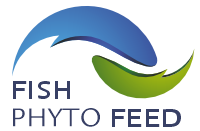Introduction
Nowadays, soybean meal (SBM) or soy protein concentrate (SPC) are the most used plant-based protein source ingredients in commercial fish feeds as alternative to partially replacement of fish meal-based diets in carnivorous fish such as the gilthead seabream S. aurata. Both SBM and SPC components contain phytoestrogens such as isoflavones the most abundant of which are the aglycone genistein and its β-glycoside conjugate genistin. The glycoside (genistin) is in greater amounts than the aglycone genistein in SBM and SPC. Literature evidence suggests that the biological activity of soy phytoestrogens does not depend upon the glycoside form. In mammals, for example, hydrolysis of the glycoside is necessary for their absorption and activity in the organism [1, 2]. Studies in fish with exogenous (synthetic) genistein-enriched diets have shown variable metabolic effects on fish depending on the genistein dose administered [3.4]. Besides, there is good evidence that exogenous supplemented genistein in the diet affects lipids metabolism as well as fish overall growth rate, produces estrogenic effects and alters fish antioxidant ability [3,4,5]. This study aims to estimate the impact of genistein and genistin on the growth performance and on the antioxidant and lipogenic mechanisms (enzymes activities) of gilthead seabream S. aurata via feeding on SBM-based and SPC-based diets and applying specific and indicative biomarkers.
Materials and methods
Genistein (GE) & genistin (GIN) were quantitatively determined in the methanolic extracts of SBM and SPC ingredients by a spectrophotometric method [6]. Three isoproteinic (49.75% ± 0.44%) and isolipidic (17% ± 0.13%) diets were formulated and produced at the IMBBC-HCMR (Anavyssos). The diets were designated as: a soy-free diet (Control), a 20% soybean meal diet (D-SBM) and a 20% soy protein concentrate diet (D-SPC). Three groups of S. aurata with an average initial weight of 27 g were fed on the diets in triplicate groups for two months. The amount of food consumed was calculated during the whole experimental period. At the end, all fish were weighted. Livers were excised, placed in liquid N2 and stored at -80oC till analysis. The specific activities of the antioxidant enzymes [catalase (CAT), superoxide dismutase (SOD), selenium-dependent glutathione peroxidase (Se-GPx)] and the lipogenic enzymes [fatty acid synthase (FAS), malic enzyme (MA), glucose 6-phosphate dehydrogenase (G6PDH)] were determined. All the enzymes activities were expressed in nmoles/min/mg protein. Statistical analysis was performed with the SPSS 13.1.
GEN and GIN content was significantly higher in SBC (~621μg/g) than in SPC (~1.6 μg/g). The lower content in SPC could be attributed either to lower content or to the extraction method that was with methanol. Growth indicators are shown in table 1. The antioxidant and lipogenic biomarkers are indicated in figures 1 & 2, respectively.
Conclusions
Findings suggest that soy-based diets with elevated dietary genistein & genistin content such as SBM-based diet could significantly increase weight gain and enhance lipogenesis in S. aurata. Contrary, SBM-based diet could lead to noticeably dysfunction in eliminating ROS production, while SPC-diet could improve antioxidant capability.


